Romania: Staking its Claim
Pharmaceutical Executive
Increasing intergration with the world economy and accession to the Europen Union have been key pillars in talking the growth potential of Romania's pharmaceutical market to greater heights.
This sponsored supplement was produced by Focus Reports.
Project Director: Béatrice Collet, Koen Liekens
Project Coordinator: Fleur Richard
Project Supervisor: Crystelle Coury
Copywriting: Andrey Muntyan, Manuel Mendoza
For exclusive interviews and more info, please log onto pharma.FocusReports.net or write to contact@focusreports.net
Increasing integration with the world economy and accession to the European Union (EU) in 2007 have been key pillars in taking the growth potential of Romania's pharmaceutical market to greater heights. Valued at $3.3 billion, Romania was recently labeled an IMS Tier 3 category of "Fast Followers" among the world's 17 pharmerging nations. "One of the larger EU members, Romania stands for an incredible market opportunity in terms of size and population—9th and 27th in the EU, respectively—offering investors a strong market potential as the second-largest country in Central and Eastern Europe (CEE) after Poland," explains Sorin Vasilescu, director of the Foreign Investment Department under Romania's Ministry of Economy, Commerce and Business Environment.

Hamangia: The Thinker and the Sitting Woman, Copyright Nicu Oprea
Regrettably, a European Commission (EC) and Organization for Economic Cooperation and Development (OECD) joint study from 2010 showed that Romania still has the lowest life expectancy in the entire EU. Historical analyses show how chronic underfunding of the healthcare system has taken its toll on the Romanian patients. According to a June presentation of the Romanian Association of International Medicines Manufacturers (ARPIM), current healthcare expenditures amount to only 3.6% of the country's GDP. In comparison, the 2009 averages in the EU and Africa stood at 8.6% and 5.9%, respectively, putting Romania in the same line with Madagascar and Burundi.
GOING DUTCH?
"We have a major dysfunction. Underfunding is recognized, there are problems regarding transparency in the allocation of funds and the inefficient use of these funds, and inequities exist in access to health services—especially in rural areas. Thus, patient satisfaction is quite low," states Romania's new Minister of Health, Ladislau Ritli. And while institutions such as the Romanian National Health Insurance House (CNAS) have been lobbying for rectification of the insurance budget, President Traian Băsescu has denied additional financial resources before the Ministry of Health (MOH) demonstrates adequate control of its spending.
Is there a way out of this vicious circle? According to Nicolae Lucian Duta, CNAS's president, increased involvement from the private sector could help. While a number of different routes can be considered, Duta presents two possible scenarios. "The first one is that CNAS remains the main public insurance fund that will finance a basic benefit package, while the private health insurance market fulfils a complementary or supplementary role. The other one is to move towards a healthcare system based on the Dutch model, where CNAS will become a regulatory body in charge of distributing the funds between several private insurance funds, which will offer variants of a basic benefit package."
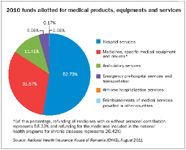
2010 funds allotted for medical products, equipments and services
"With regard to public expenditure on medical treatment, Romania regrettably holds the last place in the EU. Current expenditures are roughly €70 ($97) per person per year, which is a very low figure. At the same time, the public system is using most of the budget to purchase very expensive drugs. Therefore, a lot of people from the industry have come to believe that an important shift in Romanian public health policy is imminent," explains Laurentiu Mihai, executive director of the Romanian Association of Generic Medicines Producers (APMGR).

Nicolae Lucian Duta, President of CNAS
As the MOH has been urged to free up government funds through greater use of generic medicines, Romania has started viewing its drug spending differently. This eagerness has sparked the interest of the world's leading generic players. India's Dr. Reddy's Laboratories, for example, appointed Cristina Garlasu as early as 1995 to build a platform for growth in Romania.
Set to cross the $20 million turnover milestone this year, the country general manager reflects on the importance of Romania. "Within Dr. Reddy's global operations," Garlasu posits, "Romania forms part of the so-called G8 of countries that the company focuses on worldwide." Ascribing the attractiveness of Romania to the market's growth potential and the overall profitability of the business, Garlasu now looks at a compound annual growth rate (CAGR) of 30% through 2015, which will potentially include inorganic growth opportunities. "There is big potential in the Romanian market, which still has to grow in value and structure. This means that we also expect growth in the new therapeutic areas of success. For instance, Dr. Reddy's is successful with various biologic products in India, and I hope to be able to provide such products to patients in Romania one day. As a market, I feel we are now at the bottom and can only move up from here," concludes Garlasu.

Laurentiu Mihai, Executive Director of APMGR
The challenge for Romania's generic players is to ensure that the proper generic medicines reach patients with the support of the country's retail sector. At present, government has increasingly delayed its payments to the retail sector, which in turn creates delays with the wholesalers and eventually the manufacturers. "At the end of the day, the pharmaceutical industry in Romania has supported the healthcare system by financing it with a record €1.15 billion ($1.59 billion) in 2010," explains Makis Papataxiarchis, managing director at Johnson & Johnson Romania. Lacking liquidity has driven a high number of pharmacies into insolvency or bankruptcy, whereas surviving pharmacists consequently prefer selling innovative drugs to generate better cash flow. And all this when only 11 million out of the 21 million people in the country have proper access to medicines.
Apart from retailers, the long payment terms have pushed smaller, cash-hungry wholesalers and distributors to tap into parallel trade opportunities (accounting for an estimated 15% to 25% of the market). Now at a record 330 days, the industry remains hopeful that a recent EU Directive will take payment terms down to EU standards of 60 days by 2013. If successful, this will ensure better availability of cheaper medicines to the Romanian population.
RIDING THE ROLLERCOASTER
Apart from national insurance and health infrastructure reforms, the government has also tightened the belt on the pharmaceutical industry. In mid-2009, former Health Minister Ion Bazac imposed a crisis tax of 5% to 15% on the total sales of prescription drugs, known as the "clawback-mechanism." While government failed to collect taxes due to the vague outline of the measure, current Minister Ladislau Ritli has announced that a revised law is under way.
Far from ignorant to such measures, the industry is grasping for more air. Franz Zinsberger, ARPIM's president and country general manager of Boehringer Ingelheim, describes the current situation as a "decisive crossroads." "How far can the Romanian government go with cost containment measures, late payments, and delayed reimbursements until companies decide to downgrade Romania in the interest of their business?" Zinsberger warns.

Cristina Garlasu, General Manager of Dr. Reddy’s Romania
Others may ask themselves whether a 20-year-old market can be expected to have the same level of stability as the more developed pharmaceutical markets. "When we started the first professional evaluation of the Romanian market in 1996 it was $300 million, and today it is over $3 billion. There has been a huge development in such a short period of time," says Petru Craciun, general manager of the Romanian arm of Cegedim.
Renowned as a world leader in customer relationship management (CRM) and a trusted supplier of strategic healthcare industry data, Cegedim has leveraged its early presence in Romania. Craciun recalls how a strong customer base combined with in-depth local market knowledge reassured Cegedim during the country's more turbulent times. "The market obviously has ups and downs, and by the time the last 'up' occurred between 2004 and 2008, we were very well prepared and positioned in the market. This enabled us to reap the rewards of our efforts. On top of our customer base, there is also the local knowledge that Cegedim has been able to build upon. Local implementation accounts for at least half of the success," Craciun explains.
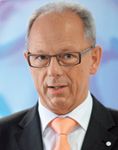
Franz Zinsberger, General Manager, BI and President, ARPIM
Never too worried about the rollercoaster pattern in his company's local revenues, Cegedim's Craciun recalls how variations of +70% and -50% must have seemed strange for newcomers in the market. "Romania was not a mature market and the dynamics were not too predictable. After a period of double-digit growth the market is now significantly challenged by the regulatory aspects and public spending containment."
In spite of the historical underfunding of its healthcare system, as a pharmerging nation, Romania has fared better than other countries in certain metrics. J&J's Papataxiarchis points out that "it is important to look at Romania's macroeconomic environment. Government debt as a percentage of GDP, for example, is the most attractive in Europe at only 34%. In countries like Hungary, Germany, and Greece, these figures run up to 72,%, 76% and 134%, respectively", Papataxiarchis says. "Romania has successfully managed to keep a stable exchange rate with the euro, which is extremely important ... The Romanian pharmaceutical market has experienced double-digit growth over the past few years, which IMS expects to continue through 2016. This is three or four times more than the average growth rate of other European countries," he explains.
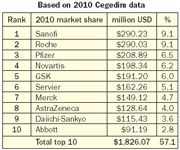
Based on 2010 Cegedim data
"Romania has all the key ingredients in terms of growth, demand, and talent. That is why it is now time to find, together with all stakeholders, the necessary resources so that the Romanian people can receive the treatment they deserve," Papataxiarchis continues. "This is why we, as well as many other innovative companies, are present here in this market. It is why we invest significantly, and why we try to reshape healthcare in Romania together with the country's policymakers," declares Papataxiarchis.
THE "FACT" OF ROMANIAN MANUFACTURING
According to 2010 Cegedim data, the top 10 pharma companies in Romania are solely innovators, holding over 57% market share. However, a look back in time reveals surprising strengths about Romania's homegrown pharma companies. Before being acquired by Sanofi and Ranbaxy, respectively, local generics companies Zentiva and Terapia already ranked among the top 10 largest players in the country, while Antibiotice and Labormed still rank 13th and 17th today. These players have pioneered Romanian generics manufacturing and are proof that the country has gathered a set of production capabilities. This, in combination with low-cost and high-skilled labor, has attracted investment from the pharma world.
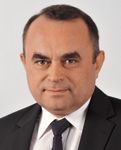
Petru Craciun, General Manager of Cegedim Romania
Describing locally acquired Sindan Pharma as a real piece of jewelry, Alina Culcea, as managing director of Actavis Romania, emphasizes how the local state-of-the-art production facility has not experienced a single quality issue in its 20 year history. Representing the sixth-largest market for the Icelandic parent today, Actavis' Romanian operations have now come to export quality oncology generics to nearly 60 countries.
Still today, nearly one-third of the value of the country's pharmaceutical market comes from locally produced medicines. The fact that these drugs may now be produced by foreign-owned entities seems of no concern to the Romanians. On the contrary, "when foreign investors came to Romania, investments in local facilities increased significantly, which brought huge changes into the management levels, and the way these businesses were run," argues ARPIM's executive director Dan Zaharescu.

Doina Ionescu, Managing Director of Merck Romania
GSK's acquisition of Europharm is a prime example of what multinationals can bring for quality upgrades. "The Brasov site started as a generics site and has now evolved into one of the most recognized GMP certified facilities within GSK," concurs Pascal Prigent, general manager of GlaxoSmithKline Romania. "We have a long-term commitment to this market when you look at the size of our local operations ... this includes production and distribution operations, as well as a consumer healthcare business. In our factory in Brasov alone, we have invested about $100 million since 1998," Prigent says.
Ioanica Geor-getta, director general of local player Fabiol, adds, "Many of the international investors that came here have seized the opportunity to invest heavily in modernizing local Romanian facilities. Now, they are all capable of producing innovative drugs in Romania, while the cost of doing so is still relatively low. Even for Fabiol, reaching out to international investors is considered to be a significant opportunity going forward."

Dan Zaharescu, Executive Director of ARPIM
While GSK's setup may be rather exceptional in terms of diversity, it has not been the only multinational to recognize the strengths of in-house distribution. "The business model we have put in place is based on having the core competences in-house," explains Doina Ionescu, country managing director of Germany-based Merck. "Merck is such a strong and sustainable brand, that we want to replicate this offer of sustainability in the Romanian market," she adds. "This relates to safeguarding the key marketing and key promotion skills, while we also improve availability of our products to better serve patient needs. For the latter, we have rented a warehouse and engaged in a managed services agreement with a logistics service provider. This model applies to both our pharmaceutical and chemicals businesses. We believe that direct customer contact and direct service to customers are the most sustainable solutions we can offer," she asserts.
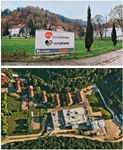
GSK - Europharm facilities in Brasov
Following the 2010 acquisition of Millipore, Ionescu saw the opportunity to generate synergies from tightening control over its distribution channel. "Among the countries where there is one subsidiary and one distributor, which is neither an emerging nor a major Western market," she recalls, "Romania was first to receive approval for the go-to-market approach. As of December 1, 2010, we therefore integrated the core competences in-house. Having a similar customer base has been the main synergy that we have achieved here."
SIGNS OF STABILITY
To prevent dialogues from becoming monologues with a witness, strengthening public/private sector relations should be key priority for pharmaceutical executives when deploying their investment strategies in Romania today. This is not an easy task in a nation which has seen a new federal health minister nearly every year for the past 20 years.

Luca Visini, General Manager of Eli Lilly Romania
Referring to any kind of interaction at the level of the industry and the institutions as "contaminations," country general manager Luca Visini of US giant Eli Lilly shares his view on successful cooperation strategies with authorities in Romania. "I dedicate a lot of time to the partnership with the Ministries of Health and Education," he notes, "for example on awareness programs for Attention Deficit Hyperactivity Disorder (ADHD). Essentially, it all comes down to allowing the aforementioned 'contamination.' From day to day, you may have converging interests with many different parties, including distributors and technology suppliers. If this contamination leads to an increase in the standard of care or the usability of the products you make available to the patients, this should be welcomed."
Walking the talk, Visini is justifiably proud of leveraging its stakeholder relations in Romania, holding 20% of the clinical studies in the country today. "In 2009, out of the 288 requests for clinical trials, the national agency approved 233 studies," Visini states. "However, getting an approval mainly depends on what exactly the company is planning to do, the way it wants to do it and what it is capable of putting on the table," he continues. "As long as we are able and successful at keeping our level of standards high, there are generally no barriers to engage in clinical research. At the end of the day, clinical trials are a sign of stability for a country. In our case, the investments in Romania imply that we are here and plan to stay here. Maybe the government does not provide clear incentives to do clinical trials in Romania but I firmly believe that approvals can be obtained if you do things the way they should be done," Visini concludes.

Steve Warner, Managing Director of MSD Romania
"I believe that you need to control what you can control. Regardless of what is going on externally, we can control our attitudes, our discipline, our focus, and our interaction with our customers," argues Steve Warner, MSD's managing director for Romania. When asked for the No. 1 driver for the American company to conduct clinical trials in the country, Warner instantly points to the access to patients driven by a high level of unmet needs. "For instance," he explains, "we have started a Named Patient Program for one of our new products, VICTRELIS, for the treatment of hepatitis C. On a global basis, around 300 patients have been allocated to this program. Romania alone accounted for 200 of them. Everyone was very impressed that we could get 200 patients so quickly, which to a large extent is related to the huge unmet needs driven by the extremely high prevalence rate of hepatitis C in Romania. There is a very large pool of patients that need this medicine, which outside of the Named Patient Program could not have had access."
Budget constraints have restricted medicines access for Romanian patients, as the government became unable to update its reimbursement list since 2008. "I understand that such revision is a challenge, but at the same time Romanian patients are being put at a disadvantage because they do not have access to the same medications as many patients in other EU countries have," adds Warner.
While the unpredictability in the Romanian pharma landscape may be a challenge to the sector's strategic minds, the high level of unmet needs and the sizeable patient base should be sufficiently convincing to justify investment for the long term. The greatest oak was once a little nut who held its ground.
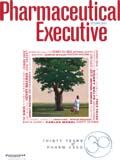
Addressing Disparities in Psoriasis Trials: Takeda's Strategies for Inclusivity in Clinical Research
April 14th 2025LaShell Robinson, Head of Global Feasibility and Trial Equity at Takeda, speaks about the company's strategies to engage patients in underrepresented populations in its phase III psoriasis trials.
Beyond the Prescription: Pharma's Role in Digital Health Conversations
April 1st 2025Join us for an insightful conversation with Jennifer Harakal, Head of Regulatory Affairs at Canopy Life Sciences, as we unpack the evolving intersection of social media and healthcare decisions. Discover how pharmaceutical companies can navigate regulatory challenges while meaningfully engaging with consumers in digital spaces. Jennifer shares expert strategies for responsible marketing, working with influencers, and creating educational content that bridges the gap between patients and healthcare providers. A must-listen for pharma marketers looking to build trust and compliance in today's social media landscape.